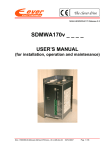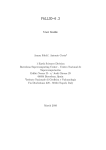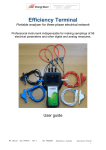Download Data sheet
Transcript
LabVIEW Driver for C300 Power Calibrator calmet C300 Three Phase Source and Automatic Tester LabVIEW DRIVER FOR THREE PHASE POWER CALIBRATOR AND POWER ENGINEERING APPARATUS TESTER type C300 USER'S MANUAL calmet Ltd. POLAND, 65-472 ZIELONA GORA, Kukulcza 18 tel.+48 68 324 04 56 fax+48 68 324 04 57 e-mail: [email protected] internet: www.calmet.com.pl C300 LabView Driver user manual 2011-02 C300 LabView Driver User's Manual 2 CONTENTS 1. Field of application ……………………………………………………… 3 2. Driver installation ……………………………………………………….. 3 2.1. System requirements ………………………………………………… 3 2.2. Installation process ………………………………………………….. 3 3. Functions ………………………………………………………………... 4 3.1. Tree.vi ………………………………………………………………. 4 3.2. Initialize.vi ………………………………………………………….. 4 3.3. Close.vi ……………………………………………………………… 4 3.4. Basic functions ……………………………………………………… 5 3.5. Harmonics …………………………………………………………… 10 3.6. Photohead …………………………………………………………… 11 3.7. Utilities ……………………………………………………………… 13 4. Examples ………………………………………………………………... 14 4.1. Generating a harmonics signals ……………………………………... 14 4.2. Automatic characteristics for voltage meter …………………………. 15 C300 LabView Driver User's Manual 3 1. FIELD OF APPLICATION This document is an user manual of LabVIEW driver for Calibrator C300 designed by Calmet Ltd. Document described driver installation process, functions included into the driver and examples of use the driver in application. 2. DRIVER INSTALLATION 2.1. System requirements Driver was written for National Instruments LabView 2009 program. For communication with the calibrator driver use dedicated DLL library CalmetC300.dll, which was created in Microsoft .Net 2.0. platform and for using the driver user have to install Microsoft .Net 2.0 Framework. It can be downloaded from Microsoft Download Center site: http://www.microsoft.com/downloads/en/default.aspx 2.2. Installation process Driver is distributed in a ZIP archive. All files from archive should be copied in to instr.lib catalog in LabVIEW program localization. Default localization is: C:\Program Files\National Instruments\LabVIEW 2009\instr.lib\ Driver is automatically added by the LabVIEW, when it is starting. In the functions palette it is localized in Express/Output/Instr Drivers/Calmet C300/ directory. C300 LabView Driver User's Manual 4 3. FUNCTIONS Each function has an error in input and error out output, that can be used to handle errors, if they occur during program execution. 3.1. Tree.vi The VI Tree displays all the user-callable VIs of the instrument driver in an organized table. 3.2. Initialize.vi Before calling any function provided by the driver, it must to establish connection with the C300 calibrator by the Initialize.vi calling subroutine. Required parameter is the name of the serial port to be used for communication with the calibrator such as COM1 or other serial ports. After initializing the calibrator in the Instance out of the terminal, the handle of calibrator connection is available. It must be used by all subsequent sub-controllers used. 3.3. Close.vi Function Close.vi must be used for terminate the connection in any program, where C300 driver was used. Instance in input must be connected with handle from Initialize.vi program. C300 LabView Driver User's Manual 3.4. Basic functions 3.4.1. SetVoltageRanges.vi Sets the voltage range for each voltage output channel. The Voltage Ranges can be one of the following values: 1 – 60V; 2 – 130V; 3 – 250V; 4 – 500V. 3.4.2. SetVoltages.vi Sets the voltage for each voltage output channels. 5 C300 LabView Driver User's Manual 6 3.4.3. SetCurrentRanges.vi Sets the current range for each current output channel. The Current Ranges can be one of the following values: 1 – 0.5A; 2 – 6A; 3 – 20A; 4 – 120A. 3.4.4. SetCurrents.vi Sets the current for each current output channels. 3.4.5. SetPhaseAngles.vi Setting the phase angles and angles between voltages. C300 LabView Driver User's Manual 3.4.6. SetFrequency.vi Setting the frequency of the output signal. 3.4.7. SynchronizeFrequency.vi Enable frequency synchronization with the power network. For disable the synchronization just send the new frequency by the SetFrequency.vi function. 3.4.8. SetStanbyOperateState.vi Sets the calibrator’s standby/operate state for each output channel. 7 C300 LabView Driver User's Manual 8 Boolean TRUE means, that output channel is turned off (Standby), and Boolean FALSE, that output is turned on (Operate). 3.4.9. GetStandbyOperate.vi Gets the calibrator’s standby/operate state for each output channel. Boolean TRUE means that output channel is turned off (Standby), and Boolean FALSE that output is turned on (Operate). C300 LabView Driver User's Manual 3.4.10. GetStandbyOperateFrequency.vi Gets the calibrator’s standby/operate state for each output channel and power network frequency measurement from calibrator’s internal frequency meter. 3.4.11. GetADCValue.vi Gets the measurement from internal ADC for a given channel. It also provides information about measurements units. The ADC Input can be one of the following values: 0 – RANGE_10V_DC 1 – RANGE_20mA_DC 2 – RANGE_10V_AC 3 – RANGE_100mA_AC 4 – RANGE_5A_AC 9 C300 LabView Driver User's Manual 10 3.5. Harmonics 3.5.1 UploadHarmonics.vi Uploads a new harmonics shape to the calibrators buffer. This shape can be copied from buffer to the shape memory of individual calibrator outputs by the SetChannelHarmonics.vi function. The Harmonics input expect an array of clusters with number, relative amplitude and angle of harmonics. See Calmet C300 Harmonics.vi example how to use this function. 3.5.2. SetChannelHarmonics.vi Sets channel harmonics signal shape, based on a shape uploaded to calibrator’s buffer. Before calling this VI you must upload harmonics to the calibrator’s buffer (by calling UploadHarmonics.vi). The Channel input can be one of the following values: 0 – DEFAULT_SIN 1 – U1 2 – U2 3 – U3 4 – I1 C300 LabView Driver User's Manual 11 5 – I2 6 – I3 See Calmet C300 Harmonics.vi example how to use this function. 3.5.3. SetHarmonics.vi Enables/disables channel harmonics. Before calling this VI you need to upload harmonics (calling UploadHarmonics.vi) to calibrator’s buffer and call SetChannelHarmonics.vi to copy uploaded signal shape to the channel. Then you can enable or disable channel harmonics. The Channel Harmonics input is an cluster of Boolean variables represents: U1, U2, U3, I1, I2, I3 channel, where TRUE means, that channel use its harmonics shape and FALSE, that use default sinusoidal shape. See Calmet C300 Harmonics.vi example how to use this function. 3.6. Photohead 3.6.1. StartPhotoheadImpulseCounter.vi Starts the photohead impulse counter. You can read impulse counter values (number, time, status) by calling GetImpulseCounterValues.vi. 3.6.2. StartPhotoheadImpulseByNumber.vi Start the photohead impulse counter to count a given number of impulses (Number of impulses input) and start counting a time in milliseconds from first to last impulse counted. You can read impulse counter, time, and status by calling GetImpulseCounterValues.vi. Timeout input set the maximum time in milliseconds between counted impulses. C300 LabView Driver User's Manual 12 3.6.3. StartPhotoheadImpulseByTime.vi Start the photohead impulse counter to count the impulses in a given time in milliseconds (Counting time input) . You can read impulse counter, time, and status by calling GetImpulseCounterValues.vi. Timeout input set the maximum time in milliseconds between counted impulses. 3.6.4. GetImpulseCounterValues.vi Gets the photohead Impulse counter values such as: number of counted impulses, measured time in milliseconds from 1st to last impulse counted, internal time in milliseconds of the test procedure, and Impulse Counter Status. The Impulse Counter Status output can be one of the following values: 0 – NOT_READY (procedure is not finished yet, Impulse Counter Values are temporary) 1 – READY (procedure is finished) 2 – ERROR (timeout error occurs) Remember, that if you want to correctly calculate the electricity meter error of full n turns of the rotor disc you must count n+1 impulses. 3.6.5. StopPhotoheadImpulseCounter.vi Stops the photohead impulse counter. Function stops photoheads impulses counting and procedure time measurement. You can read impulse counter, time, and status by calling GetImpulseCounterValues.vi. C300 LabView Driver User's Manual 13 3.7. Utilities 3.7.1. GetCalibratorInfo.vi Gets the calibrator’s description like firmware version and serial number. 3.7.2. VoltageRangeChangeNeeded.vi This VI provides information if a voltage range change is needed. It also computes the new voltage ranges. Voltage ranges terminal input must be connected to the actual voltage ranges of the calibrator, and the Voltages input must be connected to voltages value demand. If there is a need of voltage range change to higher on any channel, the Change to higher needed Boolean TRUE signal is asserted. If it is possible to switch voltage range to lower on any channel, the Change to lower needed Boolean TRUE signal is asserted. Calculated voltage ranges from New voltage ranges output are always optimal and can be send to the calibrator by using SetVoltageRanges.vi function. 3.7.3. CurrentRangeChangeNeeded.vi This VI provides information if a current range change is needed. It also computes the new current ranges. Actual current ranges terminal input must be connected to the actual current ranges of the calibrator, and the Currents input must be connected to currents value demand. If there is a need of current range change to higher on any channel, the Change to higher needed Boolean TRUE signal is asserted. If it is possible to switch current range to lower on any channel, the Change to lower needed Boolean TRUE signal is asserted. C300 LabView Driver User's Manual 14 Calculated current ranges from New current ranges output are always optimal and can be send to the calibrator by using SetCurrentRanges.vi function. 3.7.4. SampleDUT_VoltageMeter.vi This is fake Device Under Test (DUT) provided only for driver testing purpose. It emulates a simple voltage meter with an measurement error. 4. EXAMPLES Examples for applications with C300 driver are placed in Examples folder of driver. 4.1. Generating a harmonics signals Calmet C300 Harmonics.vi program demonstrate how to use LabVIEW C300 Driver to generate simple voltage with harmonics shape. C300 LabView Driver User's Manual 15 Program is going to connect with the calibrator by the COM1 serial port. The harmonics shape defined in control table Harmonics is sending to the shape buffer and then copping to the U1 channel shape memory. After that, the voltage ranges (60V), values of voltages from Voltages table (10V for U1) and the base frequency (50Hz) of signal are sending. Next, the U1 channel is enabling for harmonics and turning in to the operate mode. The U1 voltage is generating the harmonics signal as long as the STOP button is not pressed. If the STOP button is pressed, connection with the calibrator is closing and calibrator is going to automatically turning of all outputs in to the standby state. For harmonics defined in the Harmonics table, output U1 voltage should have shape like on the picture below: 4.2. Automatic characteristics for voltage meter For presenting how to perform measurement of electronic equipments characteristics, three example projects can be helpful. All examples realized the same task, but the ways how the measured points are determining are different. C300 LabView Driver User's Manual 16 Calmet C300 Simple1ChVoltageTestProcedureByNumber.vi First way is taking to characteristic constant number of measurement points from specific range of measured voltage. Calmet C300 Simple1ChVoltageTestProcedureByStep.vi Second way is taking to characteristic measurement points calculated with constant step of voltage defined by user. C300 LabView Driver User's Manual 17 Calmet C300 Simple1ChVoltageTestProcedureByTable.vi Last presented way is taking to characteristic measurement points defined bay user in table. For use example programs in real measurement system, user have to use a virtual instrument, which takes one measurement from Device Under Test. Virtual instrument created by user should be placed instead of DUT in example program. It is necessary to initialize DUT instrument before for loop in program and closing communication with DUT after for loop.























